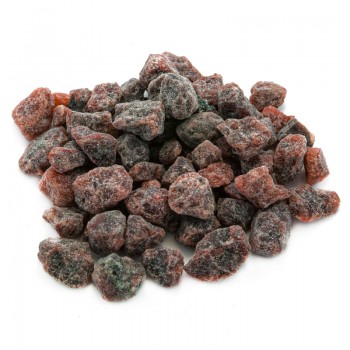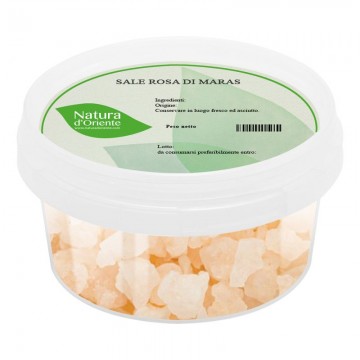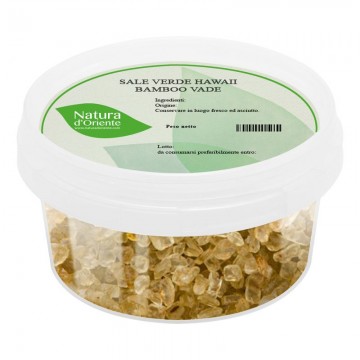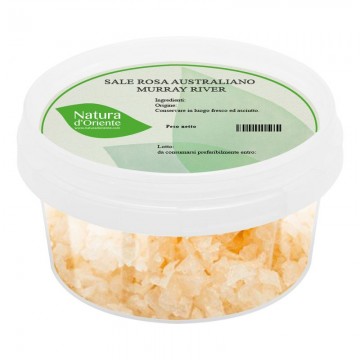Also referred to as Indian black salt , this condiment comes from the mines around the Himalayas, an extraordinary rock salt for its color and intense aroma. Its characteristics derive from the fact that it is a natural salt extracted from ancient volcanic rocks, prized and sought after as a gourmet salt. For these reasons, the grains of Kala Namak occupy a special place in gourmet cuisine; by some enthusiasts this rock salt is defined "the salt of all salts" due to the richness of its elements.
Indian Purple Salt Kala namak: features and benefits
This salt has a high content of natural minerals and trace elements, and is very rich in sulfur and iron . At an organoleptic level, Kala namak is a special salt with a strong and particular aroma. Coming from the Indian mines of volcanic origin that contain sulfur compounds, its scent and taste are slightly sulphurous, with bitter and pungent points. These notes do not exceed in the pleasant overall flavor. For this reason, the scent that brings it closer to boiled egg, Indian purple salt has become popular in vegan cuisine, especially for the preparation of the so-called vegetable egg based on tofu, purple salt and turmeric powder. Its full-bodied consistency makes it perfect to use at the moment, and to bring to the table to be used as needed on dishes. On an aesthetic level, a finish with the color of salt, between purple and blackish, due to iron sulphide, can become exceptional. Unlike common table salt, it does not increase the sodium content in the blood. It is considered one of the richest and most complete cooking salts, and for this reason it has been appreciated for millennia by Ayurveda for its digestive properties - it soothes the intestines and relieves heartburn.
Origins and History of the extraction
Kala Namak salt is formed inside volcanic rocks, and for this reason it represents an unrefined volcanic rock salt (halite). It is extracted from ancient underground deposits in India and Pakistan, at the foot of the Himalayas and for this reason it is also called "Himalayan rock salt". Its history begins millions of years ago, when in this region the sun and the terrestrial heat evaporated a primordial sea, then "trapped" in the mountains that subsequently rose. Today the salt of this sea forms the basis of the Kala Namak, which is found in deep deposits at the foot of the Himalayas, in the so-called "Salt Range". An area that includes territories between India, Afghanistan and Pakistan - between the Jhelum and Indo rivers, touching the Punjab region. Volcanic rock salt is extracted from mines (usually manually), the most famous of which are the Khewra, Jatta, Warcha, Kalabagh, Bahadur Khel and Karak salt mines. In its natural form, a very dark colored stone emerges, which is why it is called Indian black salt, which after grinding into grains changes color with gray-purple shades. Kala Namak is a special type of rock salt not chemically contaminated, pure extracted from volcanic cavities that have not been exposed to atmospheric pollution, as happens for the sea from which sea salt is extracted. As a natural product, the purple or black salt may differ slightly in color and composition even if the beneficial characteristics of the many trace minerals remain in each of the grains. Kala Namak has been used in Indian and neighboring cuisine for centuries, but is also known for its health benefits, according to ancient Ayurvedic medicine. It is used for its therapeutic and digestive properties, and is considered a refreshing and purifying spice. In ancient Ayurvedic prescriptions, Indian purple salt was used to relieve respiratory problems, intestinal gas and heartburn. Not having high levels of sodium, it was used to avoid hypertension.
Nutritional values of Indian purple salt
Kala Namak consists mainly of sodium chloride, but also contains other trace minerals such as potassium, magnesium, calcium, zinc. The traces of iron and sulfur are high, while it is not particularly rich in sodium or iodine. Among the compounds of sulfur, in particular the traces of hydrogen sulfide are responsible for the smell of eggs that characterizes this salt. The dark color, on the other hand, is due to the iron sulphide.
How to use Indian purple grain salt in the kitchen
This condiment can be used to flavor various dishes. In particular enhances ethnic dishes , in which Kala Namak is the basis of some Indian blendsof spices. Delicious in frying, to give a unique taste to soups and various vegetables. Also great in boiled potato recipes - with the addition of chives and garlic powder to the potato salad. It is a special salt when used in recipes that involve the use of egg or yolk only; with its sulphurous tone, it is particularly suitable for flavoring and flavoring omelettes. Great for sandwiches , adds flavor to rice-based recipes. Purple salt is also used to give character to some desserts, fruit and even in tropical fruit salads. Loved in vegetarian cuisine , it is one of the salts most used by vegans or by those who do not eat eggs, because it can be used in their place in salads, given the slight aroma of sulfur. It is often mixed with tofu and turmeric powder, for the preparation of the vegetable egg - for scrambled eggs of vegan tofu or vegan mayonnaise. As a garnish it can create truly extraordinary effects, thanks to the very particular color, having shades ranging from purple to gray. In particular, it is used in chutney recipes or in chaat masala , a spice blend that includes cumin, coriander, red chillies, Kala Namak, pepper and dried ginger. A mix designed to prepare spicy vegetable or fruit salads, very popular in India. It is also used to make sauces, and to make various Indian drinks pungent.
Indian Purple Salt Kala namak: side effects and contraindications
Caution is advised when taking salt in case of hypertension, cardiovascular disorders, diseases related to the kidneys and blood vessels. Furthermore, it is good to moderate the quantities during pregnancy and breastfeeding.







 No reward points for this product.
No reward points for this product.















